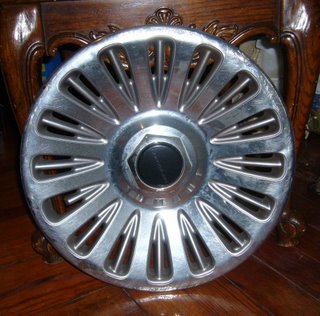A Hubcap Goes Home
 It's bad enough that, once you realize you've become a collector of something-or-other, you have to fight the urge to acquire every piece you see. Whether it's stamps or seashells, found objects or pricey antiques, the passion is the same. Then, to make matters worse, people begin ringing your doorbell proudly bearing more whatevers. You know: "I saw this and I thought of you."
It's bad enough that, once you realize you've become a collector of something-or-other, you have to fight the urge to acquire every piece you see. Whether it's stamps or seashells, found objects or pricey antiques, the passion is the same. Then, to make matters worse, people begin ringing your doorbell proudly bearing more whatevers. You know: "I saw this and I thought of you."My hubcap collection is growing--I've got a baker's dozen in the kitchen alone, if you don't count what's in the pantry. So I was happily surprised this evening to be able to give somebody else a hubcap for a change. It was one of my favorites, but I knew it was going to a good home.
Faithful readers of this blog know that I had one hubcap in my collection which was given to me by a friend after it had fallen off his car. He wasn't bothering to put it back on, and presented it to me, so I thought, why not? And just last week he bought a spiffy new Prius hybrid anyway. The old Chrysler New Yorker was going to be traded in, and sent off to the auction, where nobody would care about details like a missing hubcap.
Enter Nataria, a lovely woman of my acquaintance. I knew she needed a car, and I knew the trade-in offer was insultingly low. (The Prius is a hot item these days, and the dealers don't have to woo their customers too hard.) So I did a little matchmaking, and within hours Nataria was the excited owner of a Chrysler New Yorker with plenty of miles left in her.
It occured to me that Nataria might not share the previous owner's nonchalant attitude about hubcap replacement. I could have brought her a get-well gift when I dropped in to see how she was feeling after some minor surgery. I could have brought her a housewarming gift, as I was seeing her new place for the first time. But instead I brought her a hubcap. She appeared delighted, propping it up against a small table and admiring it.
Her knee was too sore to carry it out to the garage herself. And maybe she was just being polite by telling me not to bother doing it for her. But the hubcap did look awfully fetching there in the parlor, with the light glinting off of it. I wonder if she's planning to put it back on the car? Or has it been permanently transformed into urban art?


